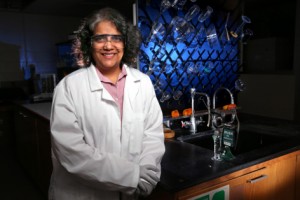
This story was originally published with the Iowa State News Service.
Surya Mallapragada believes in the power and potential of bio- and bio-inspired materials to improve human health.
She’s been researching the materials and how they can solve biomedical problems for nearly two decades. And there are good reasons for sticking with the studies.
“There’s a lot of potential,” said Mallapragada, Iowa State University’s inaugural Carol Vohs Johnson Chair (“Carol’s Chair”) in Chemical and Biological Engineering, a professor of materials science and engineering and an associate of the U.S. Department of Energy’s Ames Laboratory. “There’s a lot of value these materials can add, but the interactions of these materials with biology aren’t well understood. I think we’re doing a better job of gaining that understanding.”
What, exactly, can these materials do for people?
“A big area is tissue engineering,” she said. “That could include creating artificial organs and tissue, or using these materials to induce cell tissue growth. We could build scaffolds to promote skin growth, or materials for cartilage, bone or hip joints. There are many different opportunities.”
Researchers are also using the bio- and bio-inspired materials in new vaccine technologies. Mallapragada, in fact, is a research partner of Iowa State’s Nanovaccine Initiative, a bench-to-bedside research collaboration launched in 2013 with a three-year, $1.2 million grant from Iowa State’s Presidential Initiative for Interdisciplinary Research.
All those biomedical possibilities are keeping Mallapragada’s research group busy. They’re developing:
- Smart polymers that have charge and gel-forming characteristics that make them ideal for delivering suicide genes to cancer cells.
- Nanoscale, polymer devices that provide sustained delivery of single-dose vaccines.
- Polymers added to vaccines as adjuvants that enhance the response to sub-unit vaccines based on proteins, DNA or other parts of a virus.
- Hybrid materials that combine the lab’s hydrogels with other biodegradable nanoparticle platforms developed in the Nanovaccine Initiative to improve the effectiveness of vaccines.
- Nanocomposite materials that can be used in hip implants or cartilage repair.
- Biodegradable polymer substrates featuring tiny patterns and channels that help nerves to bridge gaps and regenerate.
The research projects have been supported by the National Science Foundation, the National Institutes of Health, the U.S. Army and the U.S. Department of Energy.
Mallapragada said many of the projects are inspired by the structures and materials found in nature, such as the chains of magnetic nanocrystals found in the tissues of many species.
“Nature assembles these beautifully,” she said of the nanocrystals. “Our synthetic polymers are moving closer to that.”
Additional progress could open the door to materials produced under mild temperatures and conditions; materials produced with greater control of size, shape, chemistry and crystal structure; and materials engineered for highly specific applications in medicine, sensors, ceramics and other fields.
“Figuring out how to do that is terribly powerful,” Mallapragada said. “Nature makes proteins with 20 or so amino acids as building blocks in specific positions. With synthetic polymers, we have two to three building blocks that we can reliably reproduce in specific locations. If we can achieve the level of control seen in nature, imagine all the things we could do.”